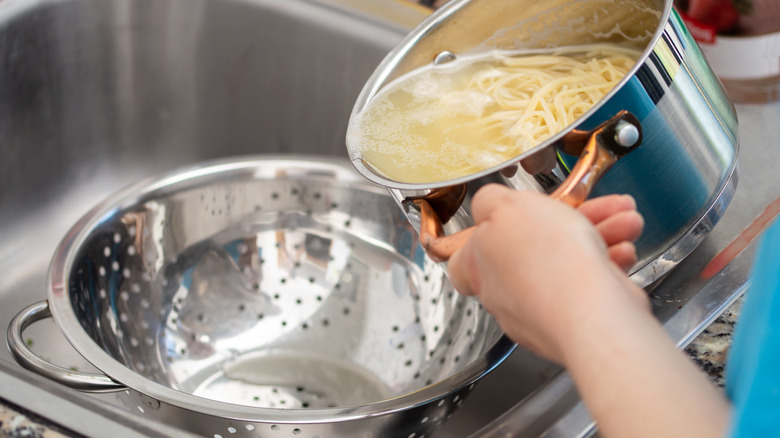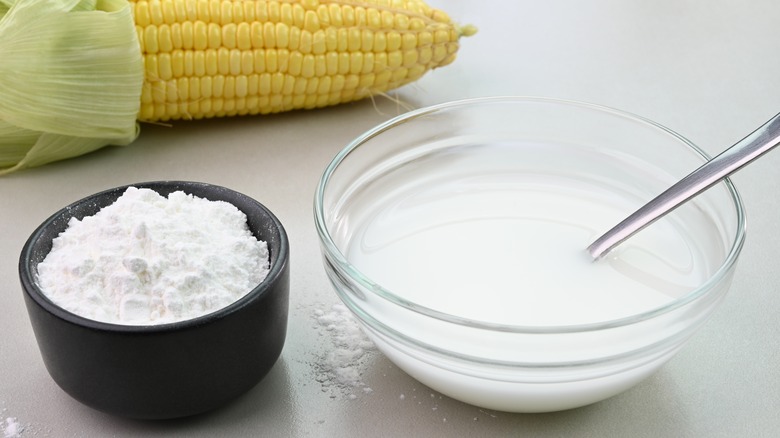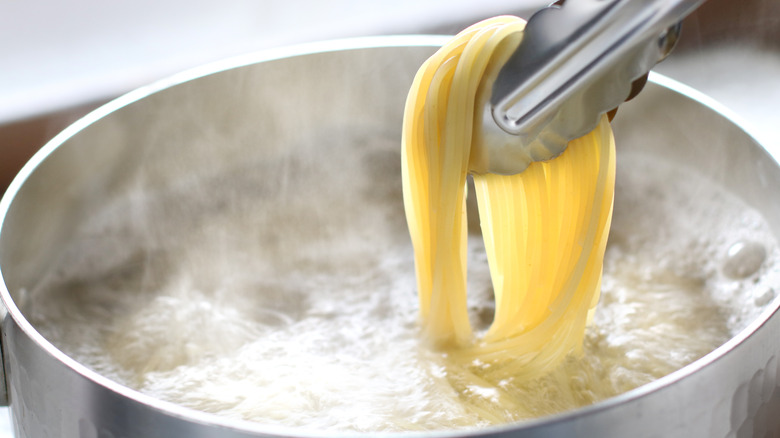What To Do When You Accidentally Dump Out Your Pasta Water
The secret to a delicious bowl of pasta actually lies in recycling the cooking water. That cloudy, murky water is actually liquid gold, filled with salt and starches that can turn your pasta sauce into silky, noodle-clinging deliciousness.
Unfortunately, when you rush to get dinner on the table, accidents can happen; before you know it, you're straining the spaghetti without saving any of that precious liquid. Fear not — instead of burning yourself trying to salvage the rest of it still trapped in the colander, we have a few solutions to pull together your pasta sauces using ingredients you probably already have in the pantry.
Instead of making another pound of noodles solely for the water, you can recreate the liquid gold by mixing two tablespoons of semolina flour with one cup of cool water. If you've made homemade pasta before, you've likely used semolina flour in the recipe. It's the preferred type due to its high gluten content which gives the pasta strength and allows you to mold and fold the dough so that it retains its shape when cooking.
Then, heat the mixture in the microwave or stovetop until combined, stirring to ensure any lumps have dissolved. Slowly add the faux pasta water to the sauce as you traditionally would, creating an emulsification that has a creamy consistency.
But, if we lost you at "making homemade pasta," don't despair; there's another way.
Create a cornstarch slurry
If you don't have semolina flour, you can also use cornstarch to thicken any liquid. Similar to thickening the gravy for your Thanksgiving turkey, a slurry made from cornstarch and water can be used in a pinch to boost pasta sauces when you've drained the water.
To do so, add ¼-teaspoon of cornstarch to 1 cup cool water. Stir the slurry until combined, and then heat it in the microwave for two minutes to activate the thickener. Slowly drizzle the cornstarch mixture into your simmering sauce as you toss the cooked pasta, until the sauce has thickened and the noodles are coated (note, you may not need the entire cup).
Also important — avoid adding cornstarch directly to your pasta sauce (even if it seems like you can shave a few minutes off your prep). Without making a slurry first, cornstarch will clump when added to a hot liquid and will make your sauce lumpy.
If you don't have or can't use cornstarch for dietary reasons, arrowroot or tapioca starch are good alternatives for most recipes, using the same ratio of starch to water. Although, if the pasta recipe has dairy, like fettuccine Alfredo, arrowroot can give it a filmy texture, so stick to the other options.
How to prevent pasta water mishaps in the future
The easiest way to avoid repeating this mistake with pasta water in the future is to stop straining your noodles through a colander. Instead, get in the habit of using a utensil like tongs or a spider to retrieve the pasta a minute or two shy of achieving al dente status. Then, place the almost-cooked pasta directly into your sauce and allow it to finish cooking there.
As you transport the noodles, water will remain trapped inside (or clinging to them) and will emulsify the sauce as you toss everything together. Once all the pasta is added, you can adjust the sauce's consistency by ladling additional pasta water in, using tongs to move everything around.
For most cooking, tongs are an extension of your hand and possibly the most helpful utensil in the kitchen, even when making pasta. They are ideal in particular when preparing long shapes like spaghetti, fettuccine, capellini, linguini, bucatini, and tagliatelle.
For short and tubular pasta shapes like penne, orecchiette, and rigatoni, and delicate stuffed pasta like ravioli and tortellini, a spider is the best tool. Its long handle allows you to reach the pasta hiding at the bottom of the pot, and its screen is small enough to prevent most shapes from falling through.
To cover all the bases, a fine mesh strainer is handy when preparing pastina or orzo. They are similar to spiders but have a fine mesh screen that prevents those tiny stars from going down the drain.



